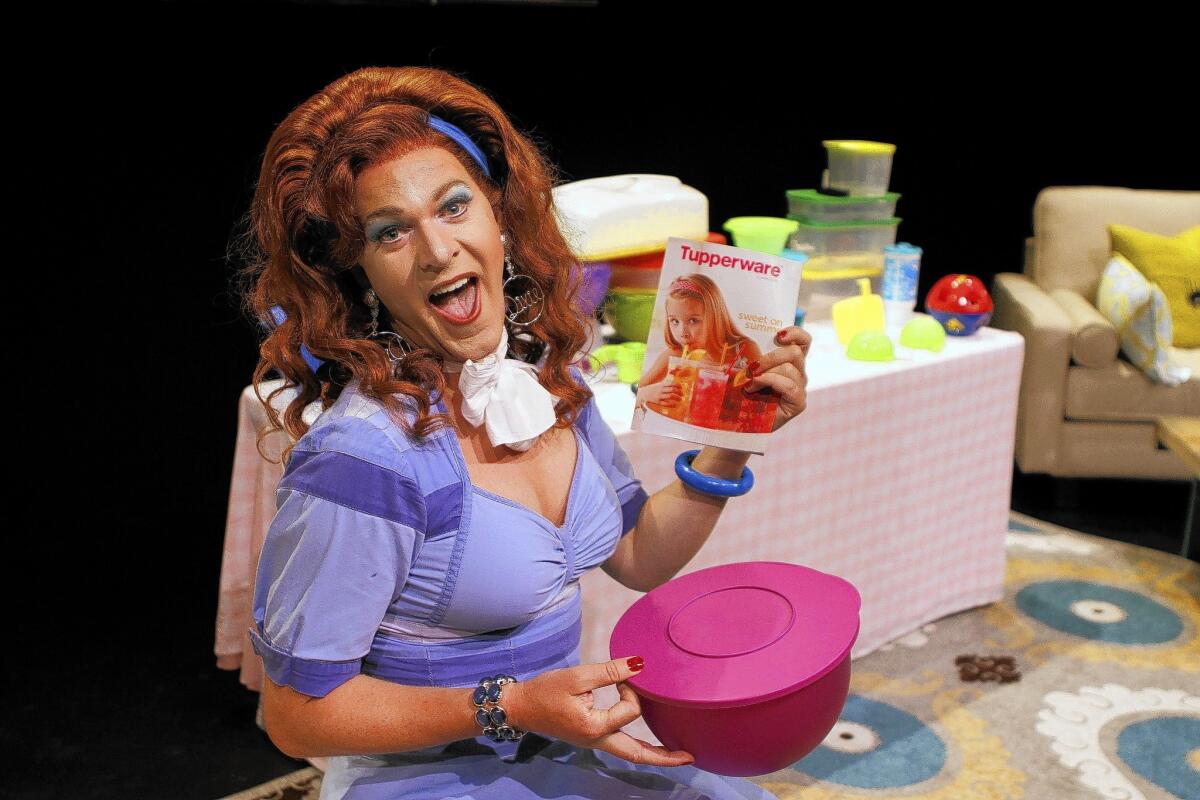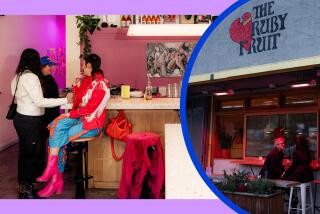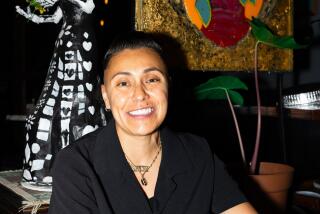Dixie Longate rings up laughs and sales in ‘Dixie’s Tupperware Party’

- Share via
Showbiz has been this route before: a man playing a woman who sports a stereotypical regional and class-specific accent, outrageous hair and accessories, and a wit wicked enough to keep the character airborne on continual gusts of laughter. Spasms, even.
Now that Dame Edna Everage has gone into retirement, the field lays wide open for Dixie Longate, just as Dixie herself does if the right man comes along, or better yet, the wrong one, especially if he’s a trucker or excels at riding mechanical bulls in honky-tonks.
Not one to buck tradition, Dixie, a Southern belle from the wrong side of town, follows the Dame in sticking to her stage persona during interviews and leaving Kris Andersson out of it. He’s credited in the program with writing “Dixie’s Tupperware Party.” It’s left unsaid that he’s also the star of the show, which runs through Aug. 3 at the Geffen Playhouse’s Audrey Skirball Kenis Theater.
The difference in outlooks between the Dame, played for decades by Australian Barry Humphries, and Dixie, concocted by Andersson as a former Alabama trailer park trollop and hoosegow denizen, is in their pet names for their fans.
Dame Edna called hers “possums.” At the Geffen these days, the $55 or $60 admission gets you called a hooker. If you like that designation, Dixie happily will sell you a T-shirt after the show emblazoned with “hooker” across the chest. She and a busy assistant also will take your Tupperware order from a checklist and summer product line catalog that’s been laid on every armrest before the audience arrives.
“‘Hooker’ is a term of endearment, you know,” Dixie said. “You want to say something neighborly, and ‘hooker’ just rolls off the tongue.”
The indefatigable star had presented herself in a blue dress, hoop earrings and high heels for a post-show interview, her third hour in character on an evening that began with her passing out white mints from a clear, sparkly Tupperware bowl as playgoers filed in. We would soon learn that the bowl was responsible for Eureka moments that enabled Dixie to find, then reconfirm her calling as a food storage container entertainer and saleswoman.
Andersson and Dixie literally have come a long way since 2008, when the current international tour began, after an off-Broadway run in 2007. The Geffen staging, their first in California, marks a return to their longtime hometown.
Before his apotheosis as Dixie Longate, Andersson’s loftiest moment in showbiz may have been his runner-up performance in the 2001 Quest for the Crown beauty pageant for drag queens at the Alex Theatre in Glendale. He presented himself as a child beauty named April Showers.
The rave Andersson won from the Los Angeles Times after the recent opening of “Dixie’s Tupperware Party” contrasted with his previous performance review by The Times, which had caught him in a 2000 stage comedy called “666 Westbourne Drive.” The show, wrote our reviewer, was “good for a few giggles with its fey gay shenanigans, [and] purposefully (one hopes) bad acting.”
Now Dixie was sitting primly in the Geffen’s guests’ lounge, the long cascading Irish setter-colored curls of her wig finally stilled after more than an hour and a half of bouncing and flapping against her back and shoulders. She had deployed a gyrating pelvis as a miming device to drive home certain punch lines.
The show may be raunchy, but it’s not nasty. Dixie simply assumes that, like her, everybody is hungry for indiscriminate sex, thirsty for booze and unashamed to show up in church on the morning after, toting sin offerings in Tupperware vessels. She makes sure everyone feels welcome at her party, including the women she singles out as “lesbians” for no particular reason.
The Orlando-based Tupperware Brands Corp. doesn’t promote her show, Dixie said, because “they want to treat all the sales force equally.” The company in fact has given her its blessing — perhaps favorably disposed by Andersson ringing up big sales since 2001, when he began appearing in drag in Orange County living rooms to sell the company’s products.
In her best year, Dixie said, she moved $219,000 of merchandise, earning a 25% commission plus bonuses.
In 2004, when they were getting ready to debut “Dixie’s Tupperware Party” at the New York Fringe Festival, Andersson and/or Dixie approached the head of Tupperware’s legal department for permission. “She said, ‘Yeah, go ahead and give it a try,’” Dixie said. “They’ve been so supportive. They said, ‘As long as you’re talking so positively about the brand and making people smile, we wouldn’t want to take that joy away.’”
As Dixie tells it, both on and off stage, she got into Tupperware sales because her parole officer said she’d have to go back to prison if she didn’t get a job; spying the crystal-like Tupperware candy dish in her minder’s office, Dixie found her calling.
“I had to leave Alabama as a condition of my parole,” she said, and she decided on Hollywood because “I’m a redhead. Nicole Kidman’s a redhead. So I’d probably be able to date Tom Cruise.”
Dixie’s timing with Tupperware has allowed her to provide comical first aid to audiences reeling from America’s worst 21st century experiences. She made her sales debut at a Tupperware party 12 days before Sept. 11, 2001, and word of mouth about her unique approach led to a steady stream of bookings in Orange County living rooms. Those initial audiences consisted mainly of “straight Republican white women, who I wouldn’t think would want a man parading around in drag,” Andersson told the New York Times in 2007 on a rare occasion when he was not wearing Dixie’s skirt.
The current tour of “Dixie’s Tupperware Party” began in September 2008, another rough moment for a nation wondering if a second Great Depression was at hand.
“People came and they were so in the doldrums,” Dixie said. “And they said, ‘You just make me smile; I’ve forgotten all the crap going on for a couple hours.’ Nothing makes my heart warmer.”
There’s a feminist cast to the show as Dixie laments the post-World War II resubordination of women as housewives after they’d demonstrated productive as well as reproductive capacities and earned a new image as Rosie the Riveter. The show’s hero is Brownie Wise, a single mother from Detroit who became a pioneering American businesswoman. In the late 1940s she persuaded Earl Tupper that his company would thrive if he’d let her take his wares straight to America’s living rooms instead of letting them languish on retail shelves.
Besides the free alcohol, Dixie said, the glory of Tupperware parties is that they bring people together in a shared face-to-face reality that she thinks is far superior to today’s electronic ersatz connectedness.
“I see so many people burying their face in their phones and disconnecting,” she said. “I always look at Tupperware as the original social network. It’s a thing that brings people together.”
Twitter: @boehmm
More to Read
The biggest entertainment stories
Get our big stories about Hollywood, film, television, music, arts, culture and more right in your inbox as soon as they publish.
You may occasionally receive promotional content from the Los Angeles Times.











